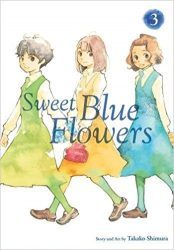Today’s review is a special sneak peak at a piece of writing for the “Big Book o’Yuri”! Thank you to all my Okazu patrons for making this possible. If you want to support my work – and to get another patron-only sneak peek from the book this spring, be part of the Okazu family! 
Deborah Shamoon, in her introduction to Passionate Friendships writes, “Prewar girls culture created a private space of girlhood, a community of friends insulated from the pressures of a restrictive patriarchy.”
By the late 20th century, the readership of shoujo manga and literature had been well trained to admire – and desire – this “private space of girlhood,” as epitomized by sex-segregated schools festooned with the accouterments of western religious orders. In the year of Maria-sama ga Miteru‘s apotheosis from popular novel to anime series, another equally influential series was being serialized in Ohta Publishing’s Manga Erotics F magazine, Shimura Takako’s Aoi Hana/Sweet Blue Flowers.
Okudaira Akira has herself admired and desired admission to an all-girls’ school, where students walk slowly so as to not ruffle skirt pleats and greet each other with old-fashioned greetings. On her way to school, the modern world intrudes on her idyll and she rescues another girl from a groper on the train. The other girl turns out to be a childhood friend of Akira’s, Manjoume Fumi. They pick up their friendship as if they’d never been apart.
Fumi is going to another girls’ school, more modern than Akira’s old-fashioned one, but no less fraught with the passions that infuse the kind of Yuri story that I have labeled a “descendant of S.”
Even though it was written for the adult readership of Manga Erotics F (an eclectic manga magazine) Aoi Hana embraces the interior lives of its adolescent female characters. The focus is not on sex, but on sexuality and the maturation of the characters’ personalities as they go through the paces of high school life. Joining clubs, making friends, school festivals remain the focus, as is common with much of manga but, after some perfunctory crudeness in the first volume, there’s a surprising lack of voyeurism; an almost an enforced naiveté, in the way the girls view – and are viewed by – the world.
Fumi is very much the embodiment of Shamoon’s “the shoujo,” with her shy personality and verbal reticence, she “does not appear as a threat,” and is meant to be seen as a Yamato Nadesiko, “pure and virginal.”
Fumi comes out several times in the course of the series, in a much more realistic example of “coming out” than usual for manga of any kind. She “comes out” to Akira early on, when she explains that she’s going out with an older student, Sugimoto. She follows this in a later volume by clarifying that she likes girls generally, has had a physical relationship with another woman prior to Sugimoto and reinforcing that she likes Akira in a romantic and physical sense. As Fumi matures, her confidence grows, as we can see in an even later volume, when she comes out again to friends and yet again to a grandmother. This kind of repeated “coming out” to different groups with differing levels of intimacy would be familiar to most sexual and gender minorities. (We can amuse ourselves imagining her later coming out to her parents, as well, although that is not addressed in the manga directly.) For this series of repeated coming out scenarios, Aoi Hana deserves a place of honor. As we’ve mentioned in the trope chapter (reference needed), although coming out is possibly the defining trope of western LGBTQ literature featuring teens (especially in YA literature) it’s largely absent from Yuri manga as a standard trope.
In the end, Sweet Blue Flowers, which gained its own apotheosis into an anime in 2009. It was dressed in the trappings of an ‘S’ tale, but was ultimately a same-sex romance told with a modern sensibility and for an audience which preferred happy endings over the “death or marriage” of early Yuri.
***

In Volume 3 of Sweet Blue Flowers from Viz, we are treated to the spectacle of Fumi’s repeated coming out and the affect it has on her circle of friends, most especially on Akira, who must find a place within herself to understand what Fumi’s feeling mean to her.
The second-years are maturing, rather quickly. Mogi is dating Akira’s brother, and Kyoko seems to have all of a sudden sprung fully into adulthood. With the even more condensed omnibus format, time seems to have contracted here and we’re almost left breathless at the changes from the beginning of the volume to the end.
This adaptation is exceptional. Reproduction and translation are all seamless, and we’re able to have a very authentic manga reading experience. The only downside of this is that it highlights the creator’s inherent weaknesses in story telling. Shimura creates character-driven narrative, but sometimes the narrative needs slightly more than just interior monologue to drive it. ^_^;
What this volume is, without question, is very lesbian. Fumi isn’t the only gay character any more now that we know that Tamashina-sensei is Ono’s older sister’s lover. And, while the impact of that is hardly touched upon in the narrative, the addition of a role model is important for Fumi. To have someone to talk to…the value of that in a young lesbian’s life cannot be overstated.
This volume is, in my opinion the strongest of what Viz will release as four volumes. We can see the progress the young women make as people, before the story turns back into itself to fulfill the requirements of a romance series.
Ratings:
Art – 8
Characters – 8
Story – 7
Lesbian – 6
Service – 1
Overall – 8
The fourth and final volume of Sweet Blue Flowers in English has a June release date. And then, we’ll be able to talk about the ending. ^_^ There’s a lot to discuss.


